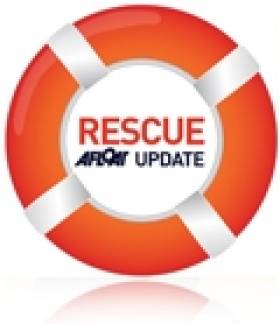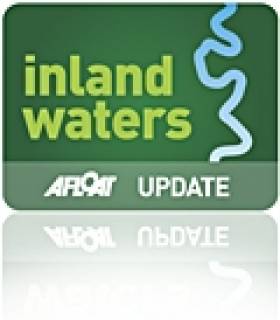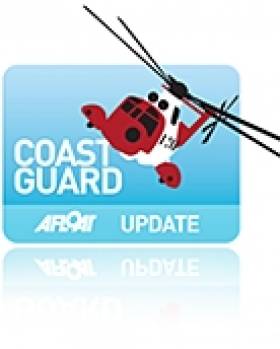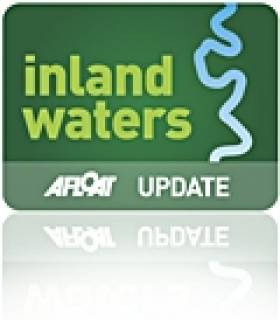Displaying items by tag: Lough Erne
Second Cruiser in a Week Runs Aground in Lough Erne
#RESCUE - Four people were rescued on Lough Erne yesterday after their motor cruiser ran aground in the second such incident in a week, the Belfast Telegraph reports.
All on board were retrieved by RNLI lifeboat from the 29ft cruiser, which is believed to have stranded on rocks beyond the marked channel of the lough.
No injuries or damage to the vessel were reported, with a Northern Ireland Coastguard spokesperson describing it as "a routine rescue".
The coastguard blamed low water levels in the lough caused by lack of rainfall in Co Fermanagh.
Waterways Ireland has posted a marine notice warning boat users of the risks posed by "the extended period of unseasonal dry weather" for Ireland's inland waterways.
In a similar incident last Friday, three adults and two children were rescued from a cruiser that stranded in shallow water on the lough.
The Belfast Telegraph has more on the story HERE.
Father-Son Duo in Charity Paddle from Dublin to Donegal
#KAYAKING - A father-and-son duo from north Co Dublin will shortly embark on an epic kayak paddle from Dublin to Donegal, the Fingal Independent reports.
Dermot Higgins and his son Fionn, from Rush, will attempt to kayak from Dublin Port to the Atlantic Ocean at Ballyshannon - a distance of some 330km - by way of the Royal Canal, the River Shannon and Lough Erne.
The Higgins' - who believe they are the first to attempt such a feat - will be completely self-sufficuent for the duration of the challenge, which is hoped to raised funds for the Rush Open Organisation for Transition Status (ROOTS), a charity that intends to help communities reduce their carbon footprint and face up to environmental challenges by encouraging sustainability.
The Fingal Independent has more on the story HERE.
Keep Animals Away from Frozen Ponds and Lakes
Belfast Coastguard, in warning the public about venturing out on thin ice said:
"There's no such thing as safe ice. If you do go through the ice, you could face frostbite, hypothermia and ultimately death if you are not rescued fast enough.
"If you're going out anyway in poor weather take your mobile phone with you; because it's cold out there, and you never know when you might need it in an emergency".
"Today in Northern Ireland, a dog drowned after falling through the ice at Enniskillen, Lough Erne. Remember to keep dogs on leads in danger areas, or avoid walking close to frozen lakes, rivers or ponds. Never go in the water after a dog - call the Emergency Services instead.
"If you do fall through the ice, try not to panic. You're going to take a deep breath when you go in, and you're going to suck some water in.
"You have to fight through that and that urge to panic. In that first stage, find something to hold on to whilst you're gasping and suffering from 'cold shock'. Once you get yourself calmed down, you're going to get really cold really fast. You're going to have about 10 minutes where you can actually do stuff and then your fine motor skills will start to fail, your fingers are going to be so cold, you're not going to be able to grab hold of stuff. You're going to have to pull yourself up with your elbows, your arms, and kick."
If you do fall in but are able to get out, you should roll yourself in the same direction to shore the same way you walked in because you know that area of ice is stable.
Angler Rescued from Lough Erne
The man who is on holiday in the area was out angling on Lough Erne in his 2.4 metre open boat, when he got into difficulty and ended up in the water. His boat which was powered by an electric outboard hit ice on the lough and the man who is in his 30's ended up in the water.
He managed to get himself out of the water and made it safely ashore to a small island called Belle Island which is in the upper Lough Erne, County Fermanagh.
Belfast Coastguard called out Erne Coastguard Rescue team, requested the launch of Carrybridge RNLI inshore lifeboat and scrambled the Irish Coastguard rescue helicopter R -118.
The man who was well equipped for angling is suffering the effects of the cold water and sub zero temperatures.
He has been recovered by the Carrybridge lifeboat from a remote and inaccessible part of the island and taken to his accommodation on the Island to warm up.
Steve Carson, Watch Manager, Belfast Coastguard said:
This man was fortunate in this incident.
Unfortunately, with the adverse weather that we are experiencing, people are still taking unnecessary risks. The weather and the forecasted weather has been widely publicised in the media. In past years when this Lough has frozen, we have had calls about people venturing onto the ice, on foot and in vehicles. This is madness, and will end up in disaster if people do not heed the warnings.
Please do not place yourself at risk anytime, but with the extreme weather we are experiencing, that message is highly important.
Waterways Ireland Classic Yacht Regatta has steam, sail and motor
Enjoy four days of classic yacht racing, steamboats, vintage and classic car displays, from Friday 27 August to Monday 30 August at the National Trust’s magnificent Crom Estate, Upper Lough Erne, Co. Fermanagh on Ireland's inland waterways.
Supported by Waterways Ireland and organised by the Lough Erne Classic Yacht Association(www.classicsailireland.com), the Waterways Ireland Classic Yacht Regatta promises to be a great weekend for yachting enthusiasts and families alike, with yachts visiting from all over Ireland and the UK. Not since 1913 when Crom was the social hub, and centre of the inland yachting world will there been such an gathering of classic craft.
Up to 100 classic sail and steam yachts are expected to fill the bays around Crom, and likely to be joined by many other visitors on cruisers converging from across the Shannon-Erne system. While classic yachts will take pride of place at this event the whole of Crom estate will be alive with activity as music, vintage cars and live demonstrations of steam powered Edwardian vessels add to the range of attractions on offer.
Commenting on the yachting extravaganza Paul Louden-Brown, Chairman, Lough Erne Classic Yacht Association said “We have had an amazing uptake in the number and quality of historic yachts booking to race at Crom. One of the many highlights of the bank holiday weekend activity is a series of races between two of Linton Hope’s one-designs. The Broad’s Brown Boats and Fairy Class Yachts from Lough Erne Yacht Club and the Royal North of Ireland Yacht Club, will compete for a special challenge trophy. This will be the first time these fleets have raced against each other.
Lough Erne Yacht Club was founded in 1837 at Crom, and the waters surrounding the castle and nearby estates are where some of the most technically innovative and historically important yachts were built and raced, many of them by the leading designers of the day like Fife, Watson, Mylne and Payne. For 80 years the leading families of the Upper Lough raced their yachts in fierce competition for magnificent silver trophy cups but all this ended with the beginning of the world war. Once again, in August 2010, yachts will race on these historic waters.”
Martin Dennany, Director of Marketing & Communications, Waterways Ireland added “We are delighted to sponsor this magnificent event combining both water and land based activities. This event will highlight the beauty of Lough Erne and the Crom Estate and encourage more people to visit this beautiful spot. For the first time ever these historic crafts will race against each other and I am sure this event will be a wonderful family event, so Crom Estate is the place to be from 27th to the 30th August.”
Jim Chestnutt, National Trust Property Manager for Fermanagh concluded “This unique event combines four days of activities around Lough Erne and the magnificent Crom Estate. Visitors will have the opportunity to walk along the banks of the Lough and take in the sights, sounds and smells of the magnificent classic sail and steam yachts. Combined with an array of other activities including vintage car displays and an opportunity for children and young persons to try sailing with Lough Erne Yacht Club, free of charge, the four day event is guaranteed to draw in crowds of visitors.”
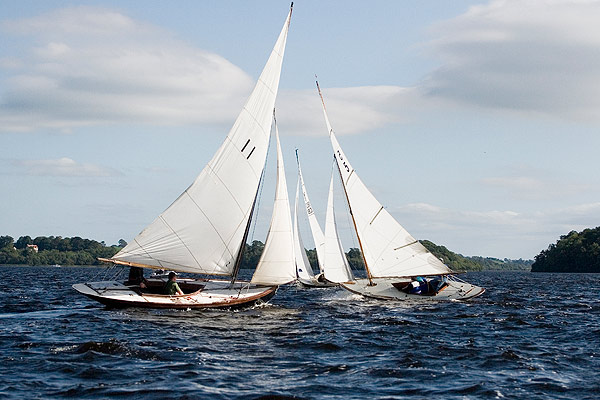
Lost Vessel Saved From Lough Erne Rocks
A 999 call from the Motor Cruiser ‘Wee Rascal’ on Lough Erne in the early hours of this morning called on all the investigative powers of Belfast Coastguard as the vessel wasn’t even close to its reported position.
The vessel was on passage from Kesh to Enniskillen in windy, wet conditions when it called 999 to ask for assistance. Despite an extensive search of the area around its reported position neither the Enniskillen RNLI Inshore Lifeboat nor Erne Coastguard Rescue Teams could find the vessel.
Because the vessel had no flares, flash lights or VHF Radio on board to show rescuers where it was, Belfast Coastguard resorted to mobile phone technology. A locator i-phone application finally gave rescuers the vital latitude and longitude they needed.
The vessel was finally located 25 miles away from its reported position, dangerously amongst the rocky shoreline off Eagle Point. It was carefully brought away from the rocks by the skill of the Enniskillen RNLI Inshore Lifeboat crew and taken to the safety of Beleek marina.
Coastguard Watch Manager Steven Carson said:
“A combination of luck and technology saved these four people from imminent danger this morning. They had charts onboard but obviously no real idea of how to get to their destination or how to report their position in an emergency.
“Vital hours were wasted eliminating one possible location after another, time that we wouldn’t have had if the vessel had struck the rocks and sunk. I hope that this experience will help the crew to realise why navigation training is essential for all mariners, whether you’re on a Lough or the open sea.”
Erne System - Temporary Closure of Jetty
Inland waterways boat owners are advised that the public mooring jetty at Lustymore Island on Lower Lough Erne will be closed to the public for construction works for approximately three weeks from Monday 17th May 2010. For further details please contact the Lough Erne Warden on +44 (0)28 6632 2836



























